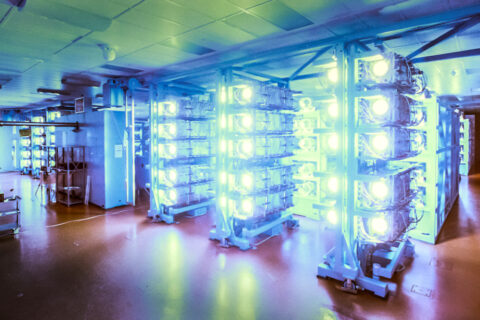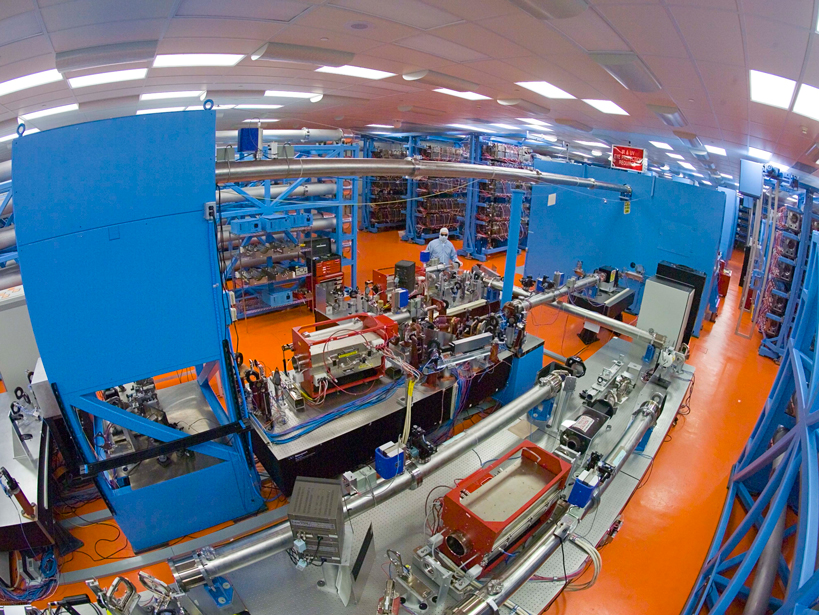With a building-sized laser and 20 technicians to operate it, scientists have replicated what they could only dream of investigating with spacecraft: the deep interiors of gas giants in our own solar system and rocky exoplanets much larger than Earth.
Scientists calculate that temperatures within Earth’s inner core reach up to 5000-7000 Kelvin (between 8540°F and 12,140°F) and pressures reach 350 gigapascals (more than 3 million atmospheres. For comparison, the deepest part of the ocean that humans have explored is slightly more than 1000 atmospheres). Larger planets in the solar system have even hotter cores that exist under even higher pressures; scientists believe that the cores of Uranus and Neptune, for example, are squeezed by 450-500 gigapascals of pressure and reach temperatures up to 6000–8000 Kelvin.
These conditions could not be experimentally explored—until now.
A paper published on 22 January in Science (doi:10.1126/science.1261507) documents how scientists used laser-induced compression waves to study how silica—a common Earth material that is often used as a model for planetary mantles—behaves under intense heat and pressures.
Through these experiments, “we recreate the interior of planets in the lab, and we study the physical properties of matter in the extreme conditions that exist inside planets,” Marius Millot, lead author on the study and a physicist at Lawrence Livermore National Laboratory at University of California, Berkeley, told Eos.
By studying high-pressure and high-temperature conditions, scientists can study the matter deep inside the planets that they cannot examine directly by launching a probe.
“By studying high-pressure and -temperature conditions, we can study the matter deep inside the planets that we cannot [examine] directly by launching a probe,” he continued. This information can be used to learn more about planetary formation and evolution.
Enter the Laser
Using the 10-meter-tall and 100-meter-long laser at the University of Rochester, Millot’s team shot laser beams at millimeter-sized samples of stishovite, a highly dense form of silica. Stishovite is rarely found at Earth’s surface (meteor impact sites hold minute quantities) so the researchers had to partner with colleagues in Germany to prepare synthetic samples.

When the laser hits the target in a vacuum, the force and temperature of the laser vaporizes the stishovite’s surface in a process called ablation, and a rebound effect (imagine the kick of a cannon) pushes an incredibly forceful compression wave into the mineral, Millot explained. The compression wave is so strong and moves so fast that it becomes a shock wave (similar to the boom of a supersonic aircraft). By observing how the mineral reacts to the shock wave, which generates enormous heat and pressure, the scientists can see how a similar mineral might behave in the cores of giant, gassy planets or rocky planets larger than Earth.
The experiments revealed that at pressures similar to what scientists believe occur at the core-mantle boundaries of rocky exoplanets larger than Earth, silica and iron have a similar melting point. Because Earth’s inner and outer cores are made up of a solid and liquid iron-nickel alloy, respectively, these findings have implications for planetary evolution and makeup.
Rethinking Exoplanetary Evolution
The traditional view of terrestrial planetary formation dictates that a newly formed rocky planet would be molten and would eventually cool after millions of years, leaving a solid mantle over a liquid outer core. However, this view rose from studies appropriate to our own Earth, and Millot’s research suggests that it is time to rethink exoplanetary evolution, said Paul Asimow, a professor of geology and geochemistry at California Institute of Technology, who was not involved in the research.
Because the study finds that liquid silica can coexist with solid iron at pressures greater than that at Earth’s core-mantle boundary, rocky exoplanets larger than Earth could have liquid lower mantles over frozen cores and thus have much different evolutionary histories, Asimow said. In other words, rocky exoplanets could host a magma ocean at their core-mantle boundaries, similar to what Earth might have experienced early in its evolution.
Furthermore, Millot found that silica at high pressures and temperatures becomes highly electrically conductive. He suggests that this deep layer of highly conductive liquid silica could help the exoplanet form a magnetic field.
However, Asimow pointed out that because silica itself is not thought to be found in the lower mantle, more research is needed to investigate how other materials such as certain perovskites, which do exist near the core-mantle boundary, behave under higher temperatures and pressures.
“Now that we’re realizing there are planets out there where the mantle extends to much higher pressure, with the core at pressure yet higher still,” Asimow continued, “we need to go and understand materials in extreme conditions.”
—JoAnna Wendel, Staff Writer

